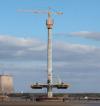First investigations into last month's collapse of one of the towers of the 446m-long Chirajara cable-stayed bridge, which killed nine workers and injured several more, have focused on the lack of reinforcement in the cross-beam. The bridge, which was planned to have a 286m-long main span, crossed a 270m-deep ravine and was 80m away from deck closure at the time of the tragedy.
The transverse slab contained tensioning strands, but the preliminary report by Mexpresa suggest the section did not contain reinforcement, which could have caused the section to fail.
Video footage of the collapse shows the tower legs moving at the point where they were connected to the transverse slab, which then led to the link with the diaphragm wall breaking and the collapse of the tower.
Consultants from Mexpresa said that they found no evidence of steel reinforcement, although they had not yet ascertained whether such reinforcement would have been necessary given the presence of the tensioning strands. The experts also highlighted the configuration of the steel stressing tendons, which connected the slab to the columns, where there was a greater number in a longitudinal direction than in the transversal.
In January, members of the American Concrete Institute carried out a drone inspection at the request of Colombia’s national infrastructure agency. After finding widening cracks, the ACI said that the existing tower could collapse at any moment.
Both the ACI and the preliminary report have recommended that the existing tower, which is of the same design and construction, be demolished.
In the meantime, concessionaire Coviandes commissioned Modjeski & Masters to carry out a study and analysis of possible causes of the collapse. Modjeski & Masters is currently on site and is tasked with evaluating the causes of the collapse, study the condition of the foundations and analyse the designs of the structure as well as the materials used.
Concessionary company Coviandes was awarded the concession by Invias for the operation and maintenance of the Bogota-Villavicencio road and in 2010 for the construction of the new Bogota-Villavicencio highway. The Chirajara Bridge is part of a programme to improve the route leading from Bogotá to the eastern plains by turning parts of it into a dual carriageway. The viaduct was being constructed by Gisaico.




